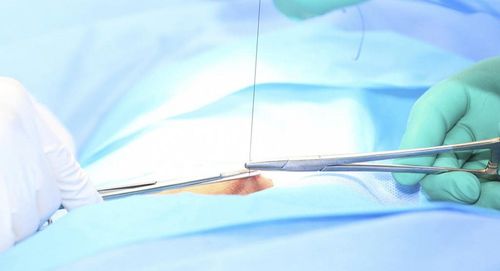This is an automatically translated article.
Ultrasound has the principle of using high-frequency sound waves to create images of the inside of the body. This technology has been around in the form of 2D (two-dimensional) scans since the late 1950s, but has only become more widely used to observe the fetus since the late 1970s. As this technology developed, doctors became more widely used. Doctors have also introduced more advanced forms of ultrasound - especially 3D and 4D (three- and four-dimensional) scanning. If it is possible to have a better view of the fetus with 3D images, the indicators in the 4D fetal ultrasound will help observe the fetus moving for a certain period of time - this is the 4th dimension.
1. Difference between 2D, 3D and 4D thai fetal ultrasound
If 2D ultrasound creates a black and white cross-sectional image of the fetus to detect potential internal defects such as heart and kidney defects, 3D Ultrasound uses more complex software to decode the image , which creates a three-dimensional image of the fetal surface. From here, the doctor can measure the height, width, and depth of the fetus to diagnose diseases such as cleft lip and spine deformity.
More advanced is still 4D ultrasound , the software creates real-time video of the fetus to show its movements, be it thumb sucking, eye opening or stretching. Accordingly, the indicators in 4D fetal ultrasound during this scan provide more information about the development of the fetus as well as the child's psychological habits and predictions, and individual behavioral tendencies.
2. The benefits of 4D thai fetal ultrasound
During the scan, the 4D fetal ultrasound will provide a clearer picture of the fetus, allowing the doctor to assess the maturation and development of the central nervous system and diagnose the possibility of cleft lip formation. In worrisome cases, neurological disorders that often present in the perinatal period and after birth are easier to diagnose through 4D fetal ultrasound indicators.
3. Indicators during 4D pregnancy ultrasound
While the 3D scan image shows a fetus on the screen as three-dimensional space in real life, the 4D fetal ultrasound indicators allow to observe the baby's movements in the uterine cavity, from spinning hair, grinning or yawning, and sucking fingers in three-dimensional space in real time. Moreover, the 4D fetal ultrasound indicators are also combined with the color doppler examination, allowing to see the blood circulation of the fetal heart, the fetal breathing movement and assess the fetal circulation status. pediatric.
Accordingly, the indicators in 4D fetal ultrasound include:
Create three-dimensional images of the face and limbs of the fetus Assess the position and structure of the placenta, umbilical cord Evaluate the amount of amniotic fluid assess the motor functions of the fetus (movement, breathing, heart rate, swallowing) In addition, in each certain stage of pregnancy, the fetus develops all 5 senses according to different milestones. Thereby, the images on the 4D fetal ultrasound will help assess how the baby responds to stimuli:
Light shining through the mother's abdominal wall Sound coming from outside the womb, for example, the voice of the mother father Breathe and swallow amniotic fluid by sensing smells and tastes Develops skin sensitivity to touch and sensation of pain Similar to other types of ultrasounds, 4D fetal ultrasound can also be done during any any stage of pregnancy. It should be noted that the smaller the fetus, the greater the ability to see the whole fetus and move the whole body.
Normally, the indicators in 4D fetal ultrasound will be examined at 26-32 weeks of pregnancy. By that time, the fetus has developed all of its vital organs and continues its rapid growth and maturation period. The fetus is similar to the infant in its body proportions. The fetus has a larger head relative to the body and therefore most of them have turned upside down on their own. In addition, the fetus has also developed the mimic muscles of the face and can smile, open eyes. A connection has been made between the retina of the eye and the brain and the child has a characteristic look into the eye. The brain's pineal gland has begun to produce a hormone called melatonin. Under the influence of hormones, the fetus will create a daily rhythm. Some fetuses are more active in the morning, others in the evening, but regardless of the schedule, the fetus still sleeps most of the time, which is 90-95% of the day.
Besides, fetuses, just like babies, in certain stages of pregnancy already have eyebrows and eyelashes. The nails cover the tips of the toes and fingers. Some fetuses already have hair, so they know how to spread their hands, suck their fingers and pull their hair. During the 4D fetal ultrasound, the doctor will also assess the position of the fetus, the fetal position in the breech position or the breech position. The size, maturity, and position of the placenta relative to the cervix are also checked.
Moreover, during the 4D pregnancy ultrasound, the doctor also checks the amount of amniotic fluid so that it is not too much or too little. Amniotic fluid helps the fetus move on its own, and as the fetus breathes and swallows amniotic fluid, its lungs and intestines are also developing.
4. How to do 4D pregnancy ultrasound?
Similar to conventional ultrasound techniques, during a 4D ultrasound, the pregnant woman will lie on her back and the doctor will apply a water gel to the abdomen then place the transducer against the abdomen.
The ultrasound machine bounces sound waves off the amniotic membrane and the fetus's internal organs to create images on the screen for the doctor to assess the health, development, and size of the fetus. When taking imaging studies over time, the doctor will record the fetal activities that make a real video so that the mother can know the baby's activity in her uterus.
5. Is 4D pregnancy ultrasound harmful?
Ultrasound is a safe non-invasive way to assess the organs and health of the fetus. However, according to the principles of medical ethics, doctors do not want the fetus or mother to do any unnecessary diagnostic tests.
For this reason, doctors only recommend pregnant women to have 2D, 3D and / or 4D ultrasound when there is an appropriate ultrasound indication according to each developmental milestone of pregnancy. This is also why it is not recommended to use non-medical 4D fetal ultrasound scans just to preserve images of the fetus for later.
In summary, 4D fetal ultrasound is a prenatal ultrasound method that incorporates the 4th dimension. Accordingly, the indicators in 4D fetal ultrasound allow this tool to not only record static images, but also record still images. There's even a video of the baby's movements in the womb. The indication of 4D fetal ultrasound is for medical reasons; Therefore, purely 4D scanning for souvenir photography is absolutely not recommended.
Please dial HOTLINE for more information or register for an appointment HERE. Download MyVinmec app to make appointments faster and to manage your bookings easily.













